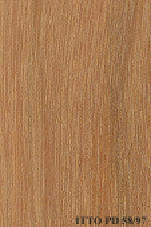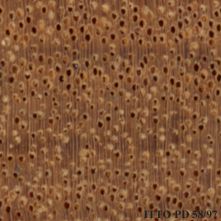
AMARILLO (Aspidosperma cylindrocarpon)
Trade Name
Amarillo
Scientific Name
Aspidosperma cylindrocarpon Mull. Arg.
Family
APOCYNACEAE
Common Names
Cabo De Hacha (Venezuela); Amargo (Venezuela); Pumaquiro (Peru); Pucaquiro (Peru); Costillo (Colombia); Canelo (Colombia); Peroba (Bolivia); Jotavió (Bolivia); Caripe (Bolivia); Jichituriqui Amarillo (Bolivia); Amarillo (Bolivia)
Description Of The Tree
Botanical Description
The size of the mature tree is reported to be small to medium, attaining heights up to 30 m and diameters of 100 cm. The boles that are free of branches for about half of the total height of the tree. Aspidosperma species exudate a milky latex.
Natural Habitat
The natural range of this species is the sub tropical dry and temperate dry forests of South America. It prefers well drained, low fertility soils, growing in primary and secondary forests.
Natural Distribution
It is reported to occur from Venezuela to Bolivia. In Brazil, this species occurs in Minas Gerais, Goias, Mato Grosso do Sul and Sao Paulo. It is reported to be more abundant in the Parana basin.
Wood Identification
Anatomic Description Of Wood
Wood diffuse porous. Vessels exclusively solitary (over 90%). Tangential diameter of vessel lumina 100 micras or less (very small). Vessels per mm2 more than 20 (very abundant). Simple perforation plates. Vessel-ray pits similar to intervessel pits in size and Apotracheal axial parenchyma diffuse and/or diffuse in aggregates. Prismatic crystals in non-chambered axial parenchyma cells. Prismatic crystals in chambered axial parenchyma cells and/or in fibers. 5 to 8 cells per parenchyma strand. Rays more than 10 per mm (abundant). Rays 1 to 4 seriate. Prismatic crystals in the ray cells. Homogeneous rays and/or sub-homogeneous rays (all ray cells procumbent). Fibers with distinctly bordered pits.
-
 Wood Macro Photo Tangential Plane
Wood Macro Photo Tangential Plane
-
 Wood Micro Photo Of Transversal Section
Wood Micro Photo Of Transversal Section
Availability
Cites Status
Unrestricted
General Wood Description
Odor
Unpleasant smell
Color
The sapwood is differentiated, it is white yellowish, the heartwood is yellow.
COLOR INDEX (1=Black, 7=Light yellow,white)
4
Grain
The grain is mostly interlocked.
Texture
The wood is mostly fine in texture.
Luster
Wood surface is high in luster.
Natural durability index (1= Very high durability, 7=Vey low durability)
3
Wood Physical Properties
Basic Density or Specific Gravity (O.D. weight/vol. green) (g/cm³)
0.65
Air-dry Density (Weight and volume at 12%MC) (g/cm³)
0.73
Total shrinkage Tangential (Saturated to 0%MC) (%)
7.7
Total shrinkage Radial (Saturated to 0%MC) (%)
4.5
Drying Defects
Ease of Drying: Air seasoning is moderate. Drying Defects: Risk of twisting and checking is reported.
Dimensional stability ratio (Total Tangential Shrinkage %/Total Radial Shrinkage %)
1.7
Wood Chemical Properties
Wood Mechanical Properties
Bending Strength (MOR),12%MC (kgf/cm²)
1171
Compression parallel to fiber 12%MC (kgf/cm²)
583
Janka hardness (side) 12%MC (kgf)
854
Workability
Sawing
Sawing of this species is easy.
Planing
Planing of this species is reported to be easy.
Boring
Boring of this species is reported to be easy.
Sanding
Sanding of this wood is easy.
Finishing
It is easy to finish.
REFERENCED USES
End Uses Summary
EXTERIOR GENERAL, crossties, HOUSING GENERAL, beams, joists, frames, TOOLS, tool handles, CONTAINERS, truck bodies, truck flooring, NAVAL CONSTRUCTION
Exterior General
- 1 - Tabela de resultados de ensaios fisicos e mecanicos
Crossties
- 8 - Maderas latinoamericas. III, Podocarpus standleyi ,Podocarpus oleifolius, Drims granadensis, Magnolia poasana y Didymopanax pittieri
General Housing
- 10 - Silica in Timbers
Beams
- 11 - Prospect: The wood database
Joists
- 12 - Tropical timbers of the world. Part I-Tropical American Species
Frames
- 16 - Woods of the World
Tools
- 42 - Utilización Industrial de Nuevas Especies Forestales en el Perú.
Tool Handles
- 43 - Maderas de Bolivia (Características y Usos de 55 Maderas Tropicales)
Truck Body
- 53 - Timbers of the New World
Truck Flooring
- 54 - Bulletin of the Government Forest Experiment Station N.157: Identification of Tropical Woods
Shipbuilding
- 55 - Tropical Timber Atlas of Latin America
Please Provide Information To View Producer Information